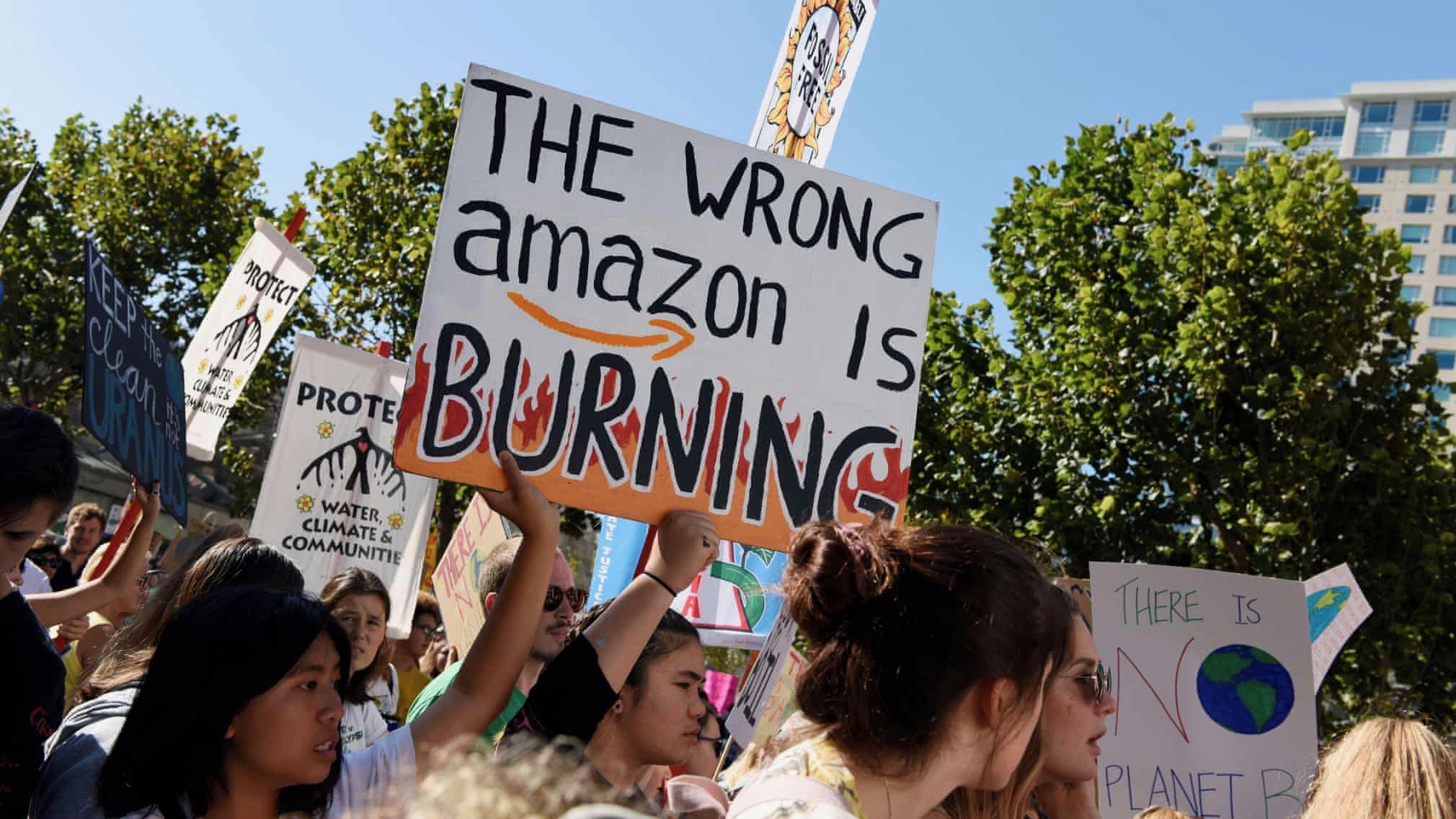Over 4 million people in 150 countries took part in the Climate Strike or the Global Day of Action on September 20, organizers said. This has been touted as the biggest ever global strike against climate change. Over the past few years, climate change has been a central cause to mobilize the masses in the Global North.
The strike was scheduled just before the United Nations Climate Action Summit, which will be held in New York on September 23. Leaders from all of the UN member nations will participate in the summit to discuss pathways and strategies to mitigate the effects of climate change on the planet.
The Global Climate Strike was part of the “Fridays for Future” movement which began in August 2018 and saw children walk out of school in order to draw attention to climate change and the need to act. The school strikes were inspired by Swedish teenager Greta Thunberg and youth and students have consistently remained at the forefront of the movement.
Thunberg sailed across the Atlantic to New York City on a solar-powered boat in order to participate in the protests outside the White House last week and in the global strike in New York yesterday. She will also participate in the UN Youth Climate Action Summit today.
The “Fridays for Future” have mobilized thousands of youth in the weekly climate strikes and yesterday’s global strike saw massive participation by school children. Several city governments like New York City took measures to not penalize students for participating in the strike, as many school children have to risk retributive action from their schools and governments to participate.
In Australia for example, the Department of Education has been scheduling assessments on Friday to deter students from taking part in the strike. Yet, many have consistently participated, risking their future. The same was done in the Seattle Public Schools system where the Friday strikes were treated as “unexcused absence”, which in turn affects the striking students’ record. In the UK, the ruling Conservative government admonished parents for protesting “at the expense of a child’s education”, while major opposition parties like the Labour and Scottish National Party have supported the strike.
The demand of the strike was for governments and other major players to address, what the organizers of the movement and a major scientific consensus call, the climate crisis. Protesters have demanded that countries reach net carbon neutrality within a decade and turn completely to renewables for energy supply. They have also sought extensive financial support from the government to compensate for such a transition and the consequent loss of jobs. The devastating fires which destroyed large swathes of the Brazilian, Bolivian, Paraguayan and Peruvian Amazon were denounced globally as a horrifying reminder of the consequences of environmental destruction.
Oceania
Beginning in Oceania, the strike saw the biggest climate march ever to happen in Australia’s history, with estimates suggesting that over 330,000 people participated in nearly 115 cities and towns across the country. Estimates from the ground said that close to 100,000 each participated in Sydney and Melbourne.
Sydney had one of the biggest turnouts across the world, with 80,000 to 100,000 people flooding the streets by afternoon. The strike brought together a wide range of political and social groups. Pictured here is a group of demonstrators from the Communist Party of Australia participating in Sydney:

Melbourne arguably had the largest showing, with estimates ranging upwards of 100,000:
There’s no end in sight at the #Melbourne #ClimateStrike
We are all taking action to make sure our Government moves Australia beyond fossil fuels, and supports First Nations communities who are most affected by the climate crisis! pic.twitter.com/TW7J0zenIJ
— School Strike 4 Climate (@StrikeClimate) September 20, 2019
Hundreds showed up outside the New Zealand Parliament building as part of the strike
Australia, New Zealand, Thailand, Japan…Global strike against climate crisis began in Asia Pacific and will go around the world all day today, this week and until change is sealed. #20SeptemberClimateStrike #ClimateChange #ClimateAction #ClimateCrisis #ClimateStrike pic.twitter.com/G33PktPemb
— Sezin Öney (@SezinOney) September 20, 2019
Europe
The 17th of June Street, near the iconic Brandenburg Gate in Berlin, Germany, was packed with a large and massive crowd. As a country, Germany had the largest turnout of all. 350.org stated that more than 1 million people participated in over nearly 500 climate strike demonstrations across the country.
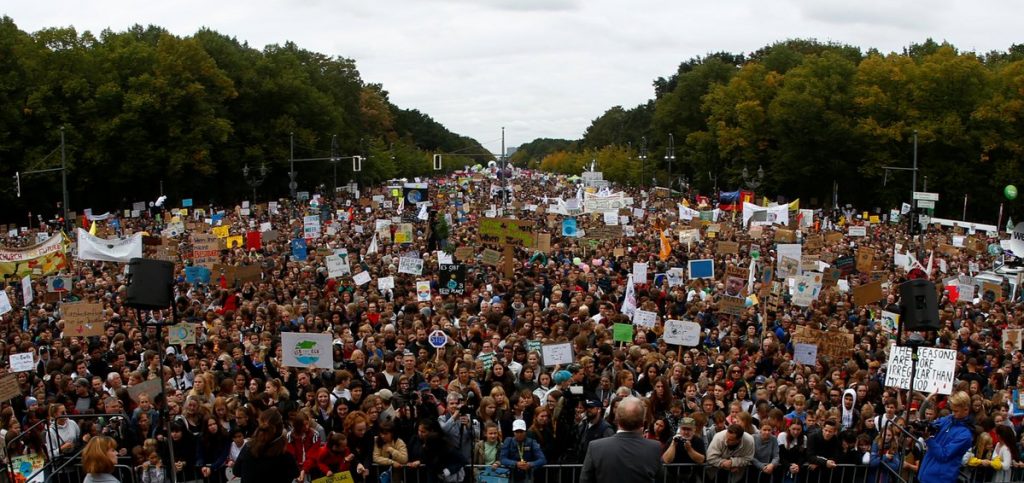
Thousands participated in a large demonstrations in major British cities like Glasgow, Liverpool and London.
Gepostet von Helen Yaffe am Freitag, 20. September 2019
Glasgow
Meanwhile in London#ClimateStrike #FridaysForFuture pic.twitter.com/KjQi54j2Le
— Eve Vuorela (@evevuorela) September 20, 2019
Africa
Among African nations, South Africa had the largest number of participants in the global strike. Thousands participated, as trade unions and several non-governmental organizations mobilized people on a large scale in Johannesburg and Cape Town. It is important to note that South African cities are among the first ones to have suffered from climate change-induced droughts, with Cape Town being the first major city to suffer a water crisis.
The South African Federation of Trade Unions joined the mobilization in Johannesburg.
— SAFTU (@SAFTU_media) September 20, 2019
March to Gauteng Legislature #ClimateStrike
Declare climate emergency
Ban on new coal power stations and fossil fuel mining licenses
Commit to 100% renewable energy by 2030 pic.twitter.com/0Gi8fg0Bs0— SAFTU (@SAFTU_media) September 20, 2019
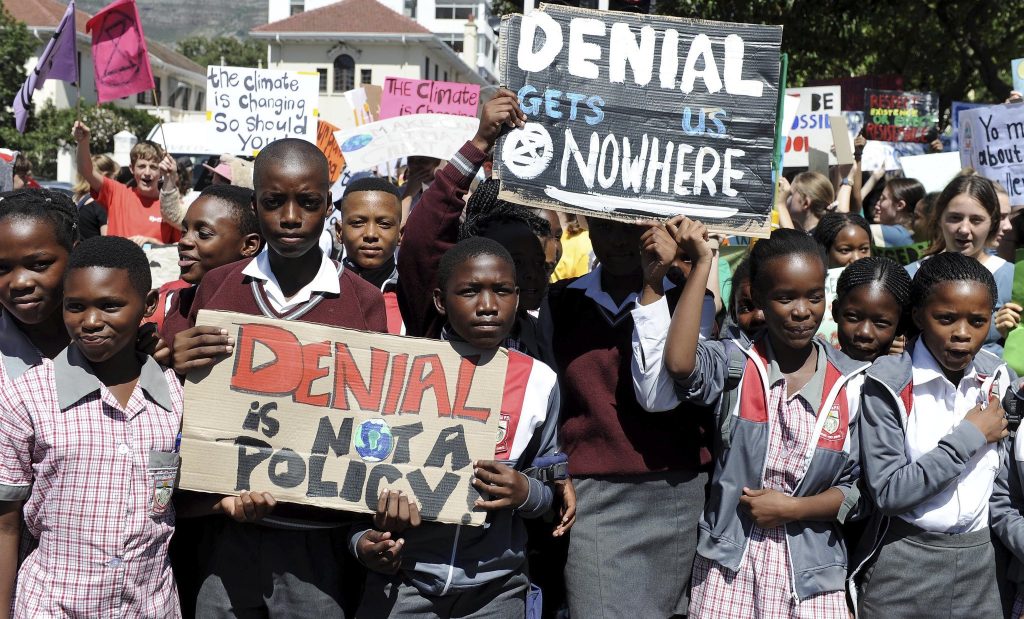
North America
In the United States, the New York City was among the largest mobilizations. With the backing from the city government and the presence of the celebrated Greta Thunberg on the front lines, thousands of New Yorkers were encouraged to flood the streets of Manhattan.
It just keeps getting better.
The streets of New York are filling up with climate strikers and it’s just getting started…#ClimateStrike pic.twitter.com/qVup0X2mg6
— 350 dot org (@350) September 20, 2019
Thousands marched to City Hall in Boston to demonstrate against climate change
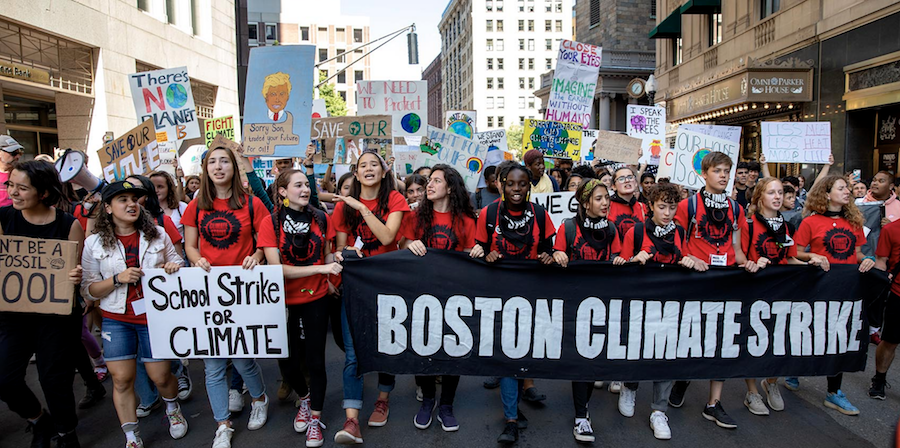
In San Francisco, school kids and college students led a large climate march, with a set of demands written on large banners.
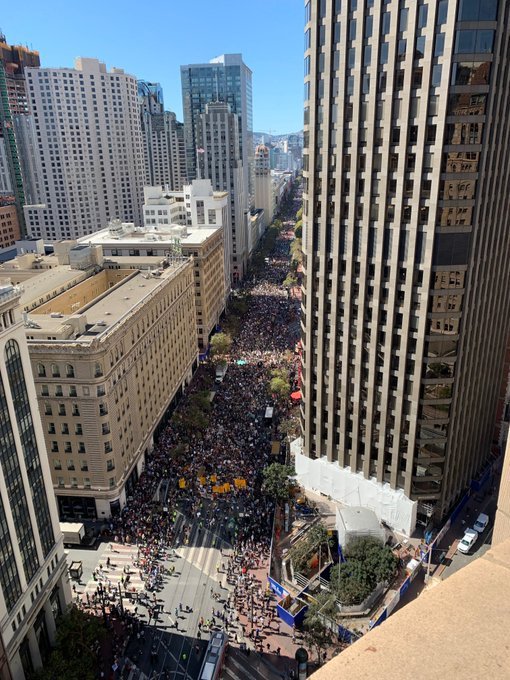

As a city that was only recently hit by a destructive flood, Houston, Texas, was among the epicenters of the climate strike this year around
In the shadow of Shell’s US HQ & #Imelda’s rainclouds, over 1k students & workers rallied at the Houston #ClimateStrike. This is a great 1st step towards building a mass movement to win a #GreenNewDeal & build an eco-socialist world!#SystemChangeNotClimateChange #FridayForFuture pic.twitter.com/PCjGOWI0k2
— Socialist Alt HTX (@SocialistHTX) September 21, 2019
The Colorado chapter of the Poor People’s Campaign also came out to participate and support the climate in the state capital, Denver. The campaign also extended their solidarity in a recent article by the campaign’s co-chairs Rev. Dr. William J. Barber II and Rev. Dr. Liz Theoharis. The article argued that “the climate crisis is, in a very fundamental sense, a direct result of our deeply unequal society and a concentration of all the forms of systemic oppression that has been cultivated over the years.”
#ClimateStrike Colorado pic.twitter.com/uDBeckiQQ1
— Colorado Poor People’s Campaign (@colorado_ppc) September 20, 2019
Latin America & Caribbean
Latin America saw several mobilizations in big cities, but like the rest of the Global South, the numbers were comparatively lesser. This however is no indication of the struggle for the environment that are taking place. The continent has been among the worst victims of climate change. It has been disproportionately affected by the intensification of natural disasters which have left several small islands in the Caribbean nearly destroyed. It is also seeing some of the highest rates of environmental devastation due to natural resource extraction which means that Indigenous communities, Afro-descendant communities, peasant and rural communities and urban dwellers have mobilized across the continent to wage sustained struggles against the “projects of death” imposed in their territories. The continent is also one of the most unsafe for environmental activists as hundreds are assassinated every year. The winner of the Goldman Environmental Prize in 2015, Berta Cáceres, was assassinated in March 2016 despite international recognition of her and her communities struggle.
In several Latin American cities, activists and organizations brought their territorial, political and intersectional struggles to the Global Climate Strike.
In Brazil, massive mobilizations were seen in cities across the country as part of the strike and they were deeply political. The recent fires in the Amazon, the environmental crimes committed by transnational mining company Vale in Brumadinho and Mariana, the dismantling of organisms of environmental control by the administration of far-right president Jair Bolsonaro, the attacks led by Bolsonaro against Indigenous and Afro-Brazilian lands as well as areas of conservation, and the indiscriminate use of agrotoxins by agrindustry, were some of the central issues raised by protesters.
In Sao Paulo, around 200 women from the Landless Rural Workers’ Movement protested outside the headquarters of Bayer-Monsanto to protest the company’s use of agrotoxins.
? MULHERES EM LUTA, SEMEANDO RESISTÊNCIA!
Mulheres Sem Terra ocupam a sede nacional da Bayer/Monsanto em denúncia no dia da #GreveGeralPeloClima#BayerÉVeneno pic.twitter.com/m5EKO3HIqS
— MST Oficial (@MST_Oficial) September 20, 2019
Colombia which is home to the world’s largest coal mine, El Cerrejón, and has more than 40% of its national territory in concessions to national and transnational extractive companies, also mobilized as part of the global climate strike. In Bogotá, hundreds marched to the Plaza Bolívar to denounce the disregard for the environment and the people by the far-right government of Ivan Duque in Colombia and across the continent with Jair Bolsonaro, Mauricio Macri, Lenín Moreno etc.
#HuelgaMundialPorElClima
A esta generación que gobierna le quedo grande separarse del modelo económico que depreda y mata el planeta.Son los y las jóvenes los llamados a defender la vida y retomar el rumbo, cuenten con migo.
Mire y vera la fuerza con la que luchan ? pic.twitter.com/3l7x72b1x8
— Jorge Rojas (@jerojasrodrigue) September 20, 2019
Thousands also marched in Mexico City to demand global action on climate change.
Así fue un poco de la #HuelgaMundialPorElClima en la #CDMX. ???? #ClimateStrike @xrmexico @fffmex pic.twitter.com/apx4ODzlHT
— Sonia Medina (@bitacora_cv) September 21, 2019
Asia
Protests were seen in many countries in Asia too. Over two dozen events took place in Pakistan, with hundreds taking part in the strike action in Islamabad.
Huge crowds at the Islamabad #ClimateMarch. There is suddenly a climate movement in Pakistan. #ClimateActionNow pic.twitter.com/jp9jHusiAL
— Ammar Rashid ☭ (@AmmarRashidT) September 20, 2019
In the Philippines too, strike events were scheduled in at least 14 places.
"One planet, one future"
Youth in Manila and 14 other cities & towns in the Philippines join the global #climatestrike. Find out how you can show your support for these amazing young people worldwide–> https://t.co/aZedaVu8dF pic.twitter.com/GKGbF0CPus— 350 dot org (@350) May 24, 2019
In India too, protests were held in various cities and in university spaces.
SFI Hindu college unit organised a human chain in solidarity with Global Climate strike at C-tree premises today. More than 50 students joined the chain.#ClimateStrike#SFI_HinduCollege
Gepostet von SFI Hindu College am Freitag, 20. September 2019
Similar events were reported from countries, such as Indonesia, Japan and Bangladesh, among others.
Voices of caution
The climate strike was undoubtedly a milestone, uniting hundreds of thousands under the banner of protecting the planet. However, quite a few voices, especially from the left, have called for further introspection and a deeper look at the politics of climate change, and sought global solidarity based on such analyses. While protests did take place in the Global South, it is undeniable that most of the major mobilizations and the movements that led to the strike were based out of the Global North. This is some senses a reflection of the different demands of the movements in these regions. Movements in the Global South have often rejected a one size fits all approach to the problem, pointing out that those who have caused the greatest amount of damage to the climate and can afford the necessary mitigatory steps – the countries of the Global North – also have a greater responsibility to take the lead on this issue. Similarly, in the Global South, the question of climate change in inseparable from those of livelihoods and economic progress, and indigenous rights, much of which has not received the necessary attention in the worldwide campaigns that led to the strike.
In a recent article published in NewsClick, Bengaluru-based environmental scientist and popular science activist, Tejal Kanitkar wrote, “When a global call for a strike is given, therefore, one has to think through what it means for everyone involved.” Pointing out that Global South nations have done far more than their fair share, at times even at the cost of their economic growth and progress, while developed nations have only shrugged their responsibility despite being the worst polluters, she argued that “climate change has to be addressed…in a manner that recognizes the divide between the developed and less developed countries, between global capital and the large mass of working people of the world.”
While stating that coming together across borders for a just solution to combat climate change is very much possible, Kanitkar raised doubts over the what the new environmental movements have to offer as they are being co-opted by capitalists.
The same concerns have been raised by others as well. Former Green presidential candidate in the US, Jill Stein, for instance, raised flags over Barack Obama’s photo-op with Greta Thunberg, detailing his history of environmentally damaging policies.
Many have also raised concerns over how the corporate media is capitalizing on the phenomenon of Thunberg, a school-going teenager. Among those include independent journalist Cory Morningstar, who has written a series of articles on how Thunberg’s imagery is used by corporates and global capitalist institutions primarily responsible for much of the environmental degradation to “greenwash” themselves.
Nevertheless the climate strike has brought global attention to looming climate crisis and has created a worldwide dialogue on ways and means to deal with it. Coming as it is on the heels of the climate summit in New York, scheduled on Monday, the strike has definitely sent a serious message across to world leaders who will be attending.


